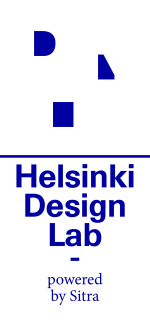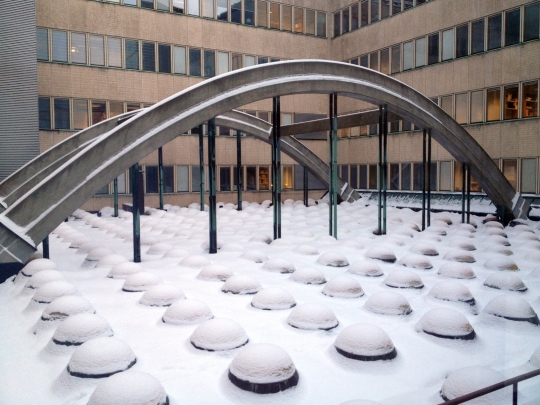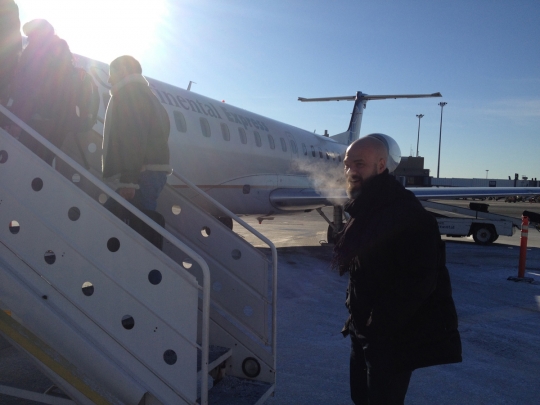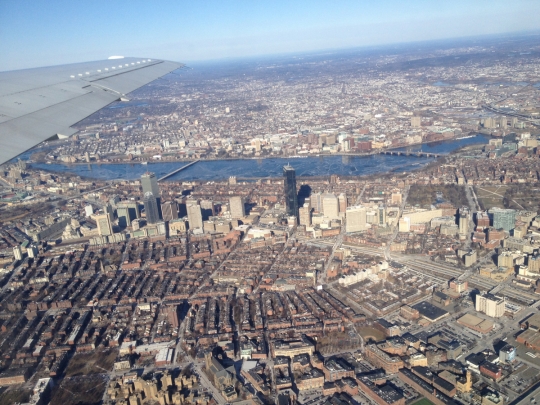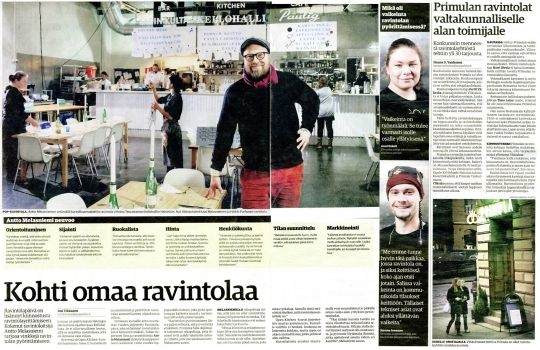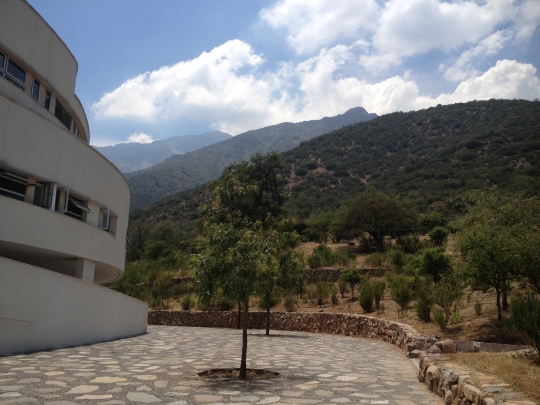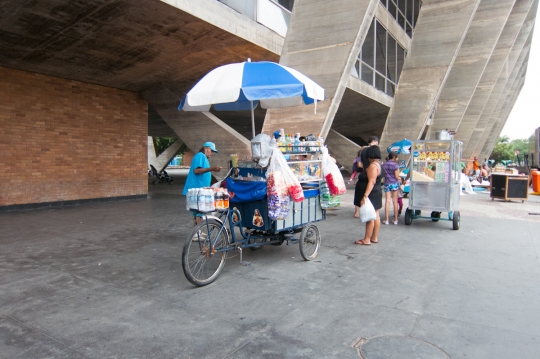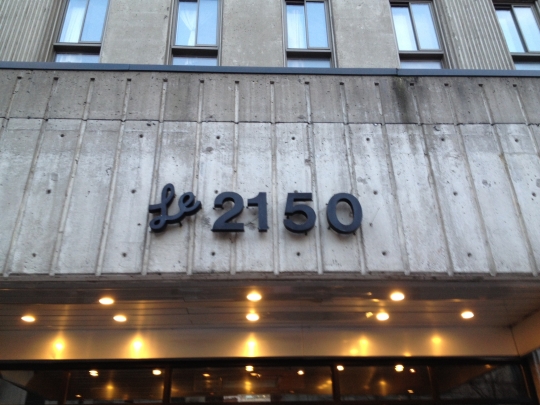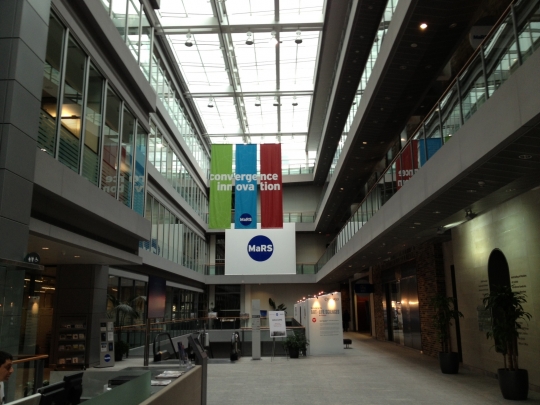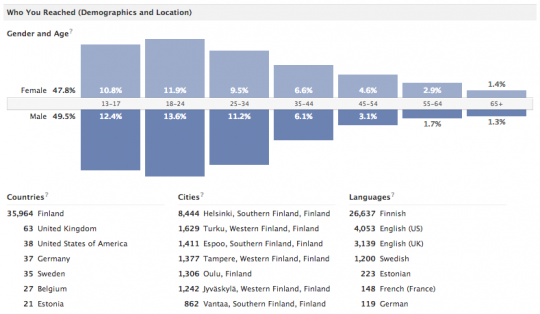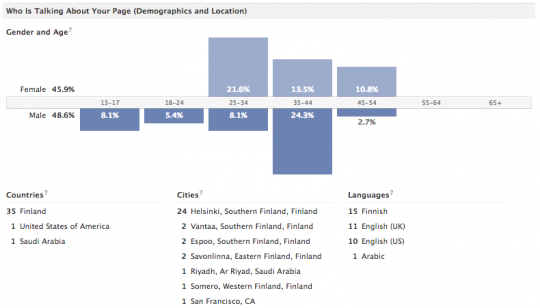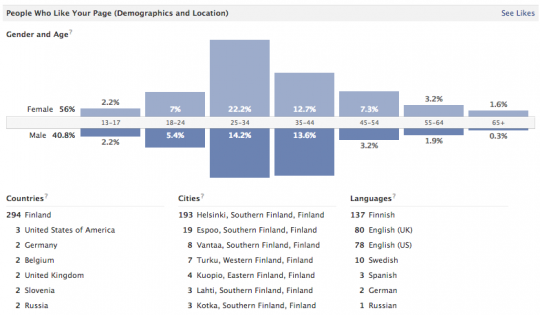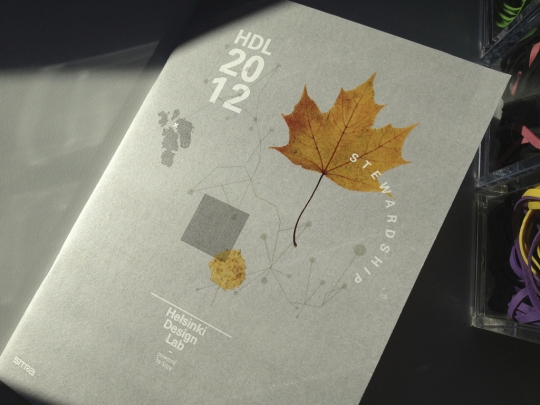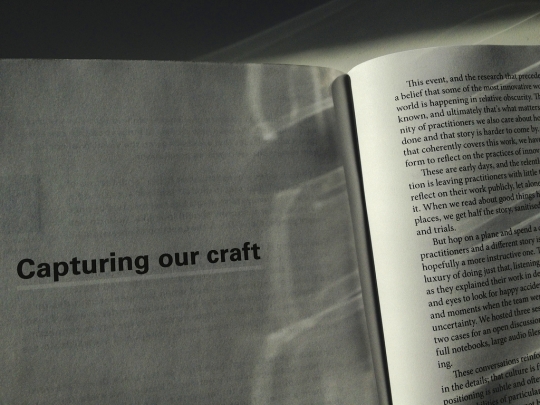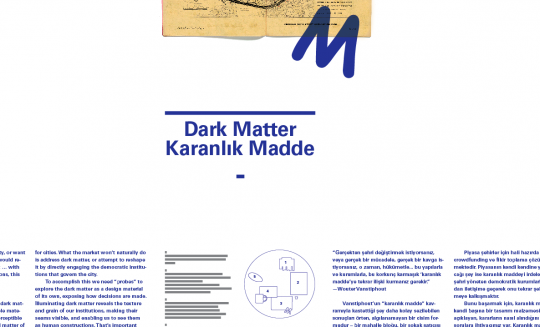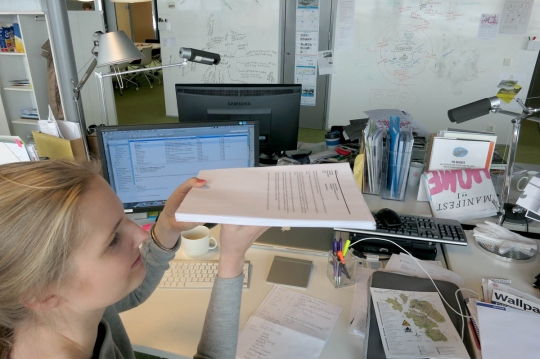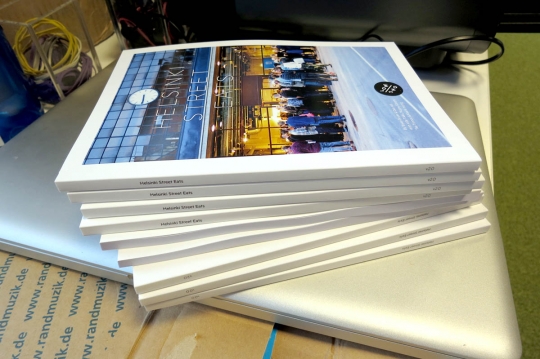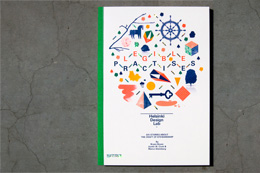Weeknotes
We've been taking care of infrastructure lately. Still some work to be done there, but not a ton. This means: being on the horn to convince people to help us with publications and other wrap-up related efforts; writing contracts to hire them; organizing bits of the office; catching up on email so that we're free from that nagging feeling of being behind.
The Design Exchange Programme is hitting its stride. Sara is finishing up her year-long placement in the city of Lahti where she was helping them redesign their approach to public engagement. As Sara is also having a baby (congratulations!) she will not be continuing and we're sad to see her go. Nevertheless, her story has been blogged here (mostly in Finnish) and will remain for reference. Thanks for being our first very courageous embedded designer, Sara!
Sirpa at the Ministry of Employment and Economy and Hella at the Ministry of the Environment have also been blogging actively, including short summaries in English.
We ended last week by hosting a breakfast with members of the city, Tekes, and other organizations around town to talk about the possibility of taking Open Kitchen forwards. If this works, we'll have been able to play exactly the role that Sitra is best at: develop a new concept, test it out, and pass onwards bettered by iterated findings.
I've enjoyed following along the developments of some of our participants as they take steps now towards opening their own ventures. You can follow Jerome as he mounts a sourdough bread revolution in Helsinki. If you're lucky, you'll get a chance to try his products; the bread wowed us all during Open Kitchen.
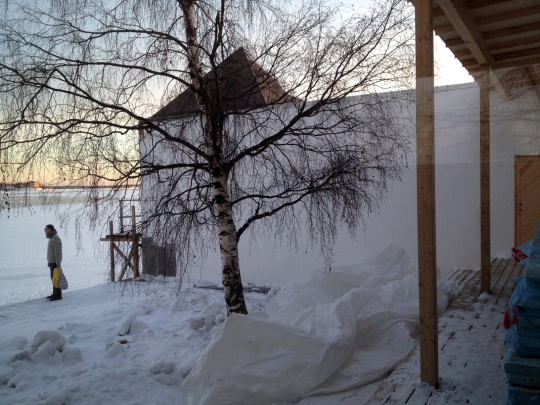
Snapshot from a visit to the Kulttuurisauna which is nearing completion.
Rory is waiting on me for final updates to the Brickstarter manuscript as I coordinate with Kali and Dan to get things just right. Meanwhile Rory is working with Bitcaves to take the manuscript forward into a book. This also serves as a reminder that I will soon need to think about revamping the Brickstarter website as we transition the active prototyping there to a project called AvoinKotka (Open Kotka).
We were very happy to see Brickstarter included in a recent issue of the magazine form, The Making of Design, with an essay by Justin McGuirk. There's also now an online video of a talk I gave at the World Design Forum in Eindhoven last autumn which discusses Brickstarter and our other projects:
Not so sure about the graphics of this video. Those are not my slides!
This week Marco is back in the office after a busy trip to the US. He and Justin were visiting the Cleveland Clinic to see an implementation the work we put together during Stroke Pathways, a research project at Harvard that served as a proving ground for our current strategic design approach. Sounds like it was an enlightening trip but I haven't had a chance to catch up with either of them for more than a minute. That's because as Marco returns I'm packing up. Tomorrow I move to New York and will be based there from February onwards as we wrap up HDL. A big change, for sure, but since we've been traveling more or less constantly for the past four years it's not going to affect our collaboration much. Though it does mean I will be waking up for some very early phone calls.
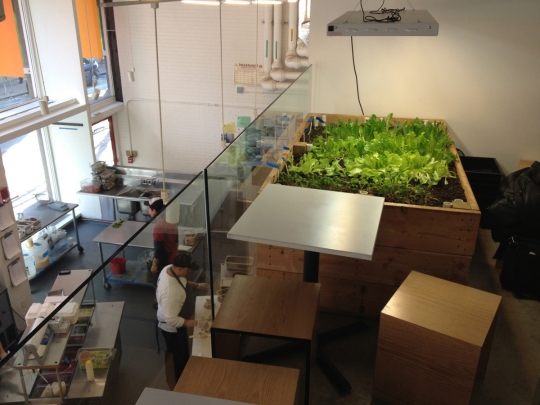
Justin and Marco visit the salad garden at Clover food lab.
While in the States Marco also had some meetings at MIT and then gave a talk at HarvardxDesign conference, which Justin and I have been advising and helping to get off the ground. Great stuff there and I swear the color similarities are just a coincidence!
We're still working through the responses to our HDL road show announcement, which means there's time for you to throw your name in the hat if you would like us to come give a talk.
Undoubtedly, readers of this blog have already read Marco's post from last week, but in case you missed it, we've recently made an announcement about the future of HDL. Hearing from the community around HDL in the wake of the announcement has been encouraging. Thanks to all of your for your continued interest in our work. I hope we are able to sustain it for the next five and a half months because we have no intention of slowing down.
On the contrary, there's still lots to do. With the ending point for HDL clearly marked on the horizon, we're entering a kind of Benjamin Button mode. We'll be getting back into the habit of writing how-tos, working from practical issues ("how to budget a project", "how to brief a photographer") through to some of the more fundamental aspects ("what abilities are needed in a design lab", "how do you pick projects"). We'll be talking through and explaining how we set up HDL so that the site becomes as useful an archive as possible for others, elsewhere looking to do something similar.
Marco and I have been spending time at the whiteboard tracing out a loose plan for the HDL closing event on June 10th. It's going to be free and open to all, so I hope you'll sign up and consider joining us. We're also keen to hear your feedback and questions about HDL and the work we've been doing. This will inform our efforts to ramp things down.
Back on the whiteboard, we've also been revisiting our proposed table of contents for the forthcoming book on stewardship as well as generally trying to get a handle on all the things we want to do before sweeping the floor and turning out the lights. Tomorrow we'll have a conference call with Justin and loop him in. This is one of the ways we usually work: a couple people bat ideas around until there's something there, then we make a little presentation to the others and start over.
Open Kitchen got a nice write-up in Kauppalehti recently. We're happy to see the Facebook group for the participants still active and are hoping to join them for a small reunion next week. Right now Mariaana, a journalist we asked to sit in on the programme, is writing up notes from each of the courses and we will be publishing those online as soon as we can. Next week we're also hosting a small gathering with some local stakeholders to see if we can find a more permanent host for the programme.
This blog post is the second of the night, behind what I just put up on the Brickstarter site. Over there we announced that Sitra will be publishing a Brickstarter book in 2013 (yup, more writing) as well as beginning a very small experimental effort with the city of Kotka in eastern Finland.
My main focus at the moment (and through much of the holiday) is getting the manuscript into shape. We're using the blog as a starting point for that, but revising and updating things with new content as well as making sure they work equally well on the page. I particularly enjoyed writing the introduction, which includes the epic battle between wind turbines and glider squirrels. You'll have to read the book to find out who wins.
We've also been working on a quick project with Two Points, the graphic designers who created the HDL visual identity. I'll leave the content of the project a surprise for now, but here's a small clip from one of the files they sent. It's part of a poster.

Next week Marco takes off on a trip to the US where he will be participating in the By Design event at Harvard. He'll also meet with some people at MIT and make a visit to the Cleveland Clinic, which is now testing some of the ideas developed during Stroke Pathways, a project that Marco led at Harvard (and Justin and I contributed to) which laid the groundwork for our strategic design approach here at Sitra and HDL. We're anxious to hear how it's going there.
On the theme of travels, we're going to make an effort to be out and about even more than usual in the coming months. If you're interested in having an HDL or strategic design perspective at an event near you, drop us a line. No promises, but we'll try our best to be accommodating.
Onwards!
In 2008 Sitra set out to build a strategic design capability. The innovation challenge at the core of its mission required the ability to design and deliver integrated solutions. Since its inception the team at Sitra has been pioneering the notion of design applied to shape the public sector.
For the past four years we've been working to develop experimental projects, as well as research, reflect upon, and articulate the practice of strategic design. In that time "strategic design" has gone from being obscure to resonating with many. Today I am writing this letter to explain why Helsinki Design Lab will close in June and what you can expect from us in the meantime.
Since its inception in 1967, Sitra has been evolving. Within the latest transition, design at Sitra is shifting from a strategic to a service role. The current members of the design team (Bryan, Justin, and myself) are committed to strategic design and will therefore pursue this interest beyond Sitra. In the spring Sitra will hire for a new role to grow service design within the organization.
One of the first things we did in building HDL in 2008 was to dig into the archives from the sixties to be inspired by the legacy of the Industrial, Environmental and Product Design conference that Sitra sponsored (HDL 1968). During the next seven months we will be converting this site into an archive of the most recent phase of HDL. The archive will be legible, free, and open.
Our intention is that the work and experience of Helsinki Design Lab be useful not just for the next phase of design at Sitra, but for the community as well—that’s you. Our model for the HDL archives will be a seed bank. We hope that you are able to take the seeds of our work forward to find new contexts and new uses.
The first thing we will do is compile our case study research from Helsinki Design Lab 2012 into a forthcoming publication on stewardship. Our tentative publication date is May 2013.
Second, we will be hosting a public event in Helsinki on June 10th, 2013. This is a true experiment, as we’ve always done smaller gatherings. If you are interested in joining us this summer please add your name to this list so that we can be in touch as plans develop. The event will be free to attend, but you’ll have to cover your own expenses.
Our objective is to provide a platform for the strategic design community to share experiences, and we’re particularly interested in design as a driver for innovation in the public sector. We will focus on three specific audiences:
- Educators: how do we educate strategic designers?
- Practitioners: how do we increase the supply of practices capable of providing strategic design services?
- Commissioners: how can governments and foundations commission strategic design?
These themes are drawn from the questions and inquiries we have fielded over the years. During April and May of this year we intend to be on the road, meeting with you, giving public talks, hosting workshops, and making ourselves available to share the work of HDL. If you are interested in hosting us, please send a note here. Our resources are limited, but we will use your feedback to craft our itinerary.
We are also interested in the questions that you may have about HDL, our projects, and/or strategic design. If we get a critical mass of questions, we'll construct an extended FAQ. Your contributions are essential for this. Please visit this page to leave your feedback.
From July 1, 2013 the HDL website will go into hibernation mode. All of the content will remain available but weeknotes will cease and there will not be anyone responding to emails.
Undoubtedly this will be a surprise to some, but rest assured that the team is as committed as ever and we're looking forward to a very busy next few months. To some, closing may be interpreted as failure, but to us it's the realization that HDL has accomplished what it set out to do: to demonstrate that design can play a valuable part of strategic decision making, to grow a community around this practice, and to advance the discourse. As all good undertakings come to an end, they invariably make room for newer and better things. The next steps we all take together.
Sincerely,

In another window I'm working on a draft of the feedback form we will send to the 12 Open Kitchen participants. That makes this weeknote a procrastination technique. Again.
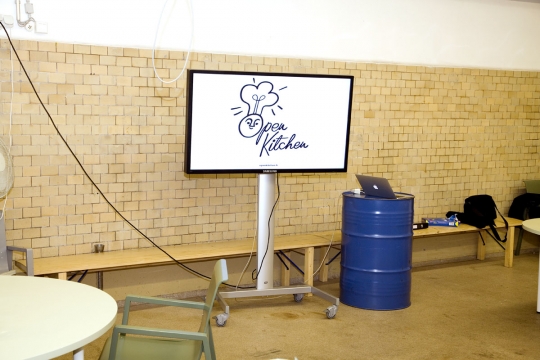
A snapshot from the opening of Open Kitchen. And a bunch more photos below. Photo: Matti Tanskanen
We've been heads down these last three weeks.
Maija and I are working on a publication to wrap-up the work on Brickstarter. Sitra's not in a position to build the whole platform ourselves at the moment (though we are probably building a nano-micro-proto), so we're transferring our momentum there into a publication that coalesces three things: urbanism, governance, and emergent initiatives (or perhaps Peer Progressivism?). The goal of the publication is to simmer down our blog a bit and prepare a limited primer on these issues that will hopefully benefit anyone interested in building a platform to support bottom-up urbanism, and perhaps people who are using such platforms to build the city.
A recent call with Dan Parham, co-founder of Neighborland, helped clarify my thinking around the next steps for Brickstarter. As Dan Hill and I have always tried to emphasize when showing the Brickstarter mockups, the ideas are not the hard part necessarily, so I've been a bit embarrassed by the press our project has received because the attention should really be directed to Neighborland and others who are putting the ideas into practice.
Since we don't have a live platform we haven't been prototyping with users, but we have been prototyping with another group: civil servants. The reason we jumped right to high resolution mockups is so that they're plausible, and perhaps even a little scary, when we show them to our colleagues in city hall and elsewhere. Part of our challenge has been to find a language and a narrative that helps the public sector recognize the potential "threat" of citizen-initiated urbanism, and in doing so help them lean into it, rather than shy away. Because, of course, it's not a threat at all—quite the opposite. We're getting close to having an agreement with a town in eastern Finland to put a subset of the Brickstarter ideas into practice.
After talking with Dan, I'm retooling my thinking on the publication a bit and focusing more on how our work might offer a language and narrative that helps others build the connective tissue between government, citizen groups, and the technologists who build collaboration platforms. If we can do that, I would be very happy.
We've brought in Rory Hyde to help us as an editor for the Brickstarter wrap-up. It's great to have him, not only because his own work on unsolicited architecture overlaps with Brickstarter, but because he also brings structure to our work. Thanks to Rory's careful work on the table of contents and overall structure I'm now hyper conscious of the fact that our introduction is 35% too long. Time to lose 1000 words. This is my favorite part (really).
Maija's working on some text to summarize the Fact Cards, as well as a set of diagrams that map them out relative to each other. We'll crunch on this right up till the end of the year, but I'm resolved to have the final draft of the manuscript done by the new year.
Marco was in Chile to give a talk at the Architecture Biennale there, and a number of other things. He reports back that it's an exciting moment in Chile, but then again readers of this blog know that we're fans of the strategic design work happening in that country.

Marco was quite happy about summer in December.
Justin was in town for a week, wherein he and Marco spent a good portion of it sequestered in a conference room hashing out a publication on Low2No. With that project transitioning to our market partners VVO and SRV this is a good moment to step back and reflect on what we've learned. That's the gist of the book, but I'll let Justin introduce it more properly when things are more fixed.
Somehow without trying to we've become a publications house. I'm glad that words are a renewable resource, or we might be in danger of using them all up.
Open Kitchen launched on December 3rd, but I think it's best to start with this, a new video that Kalle and I finished to coincide with the launch:
The Facebook page for the project is the best place to get a sense of how things have been going. Our participants spent about 1.5 weeks learning from experienced food entrepreneurs around the city, then the second 1.5 weeks have been dedicated to figuring our a shared restaurant concept and putting that into motion. Last night I had my second meal at Open Kitchen and it was—forgive me for bragging on behalf of the group—excellent! I'm really proud of what the participants have put together.
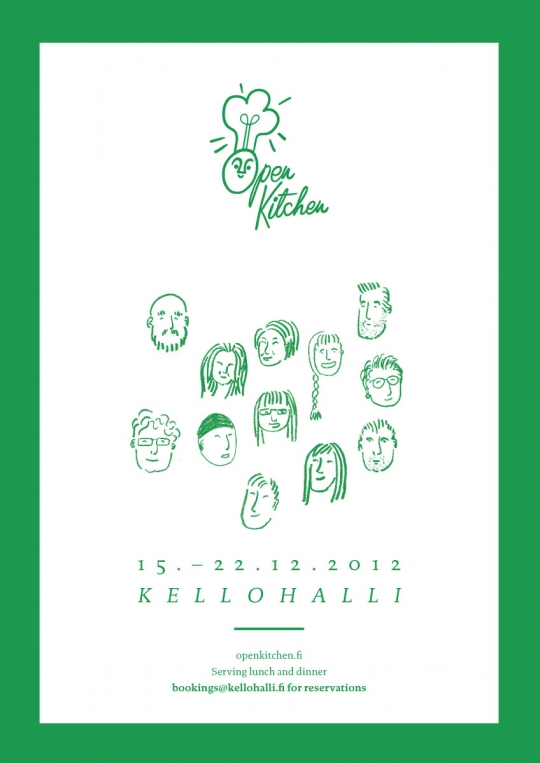
Inka Kosonen and Mari Sollman, two Aalto University Masters students, have been working with the team to create and execute a visual identity for the materials and interior at Open Kitchen… all in 3 days.
With things running more or less smoothly, we're now turing our focus to next steps for the programme. In January we'll be hosting some sessions to see if we can match the programme with a funder who would be interested in taking it forward on an ongoing basis. From this perspective, we've treated Open Kitchen as a mechanism to produce evidence. It is testing the viability and usefulness of a 3 week course as well as proving the market for such a thing. Sitra has taken the upfront risk in hopes that we will find a partner to carry it forward. That's always easier with even a modicum of evidence.
There will be more to say, but for now I'm going to end this post with some photos that document the first 2 weeks of Open Kitchen.

Tuuli Kaskinen of Demos Helsinki talking about food sustainability.
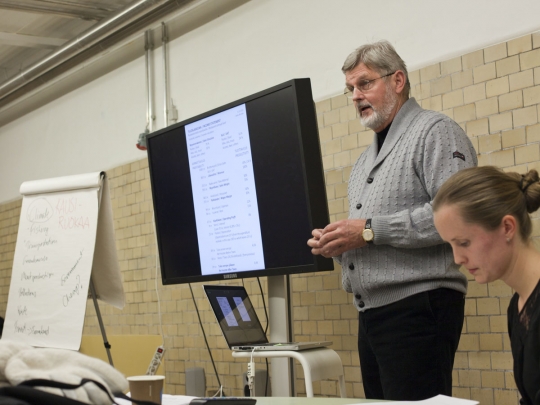
Aimo opened his first restaurant for the Olympics in 1952.

Cynthia Shanmugalingam of Kitchenette talks about food trends in London. Photo: Matti Tanskanen
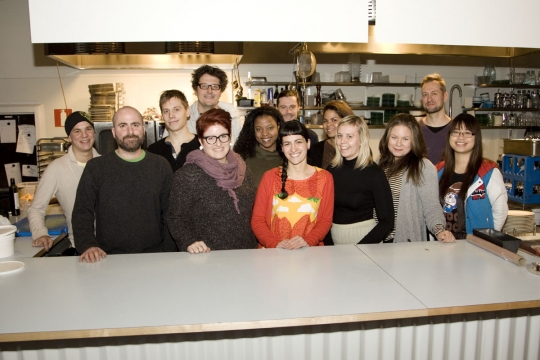
The team! Photo: Matti Tanskanen
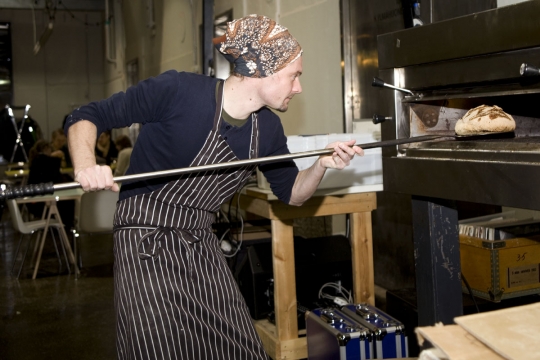
Jérôme putting bread in the oven. Photo: Matti Tanskanen
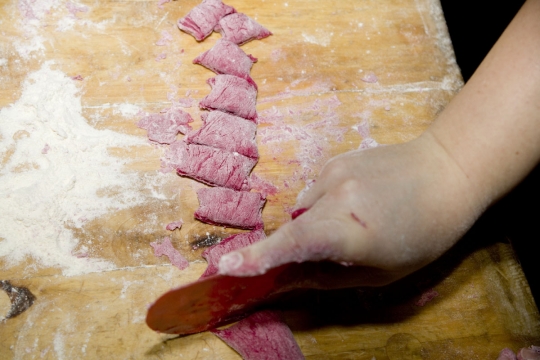
Beetroot gnocchi in the making. Photo: Matti Tanskanen
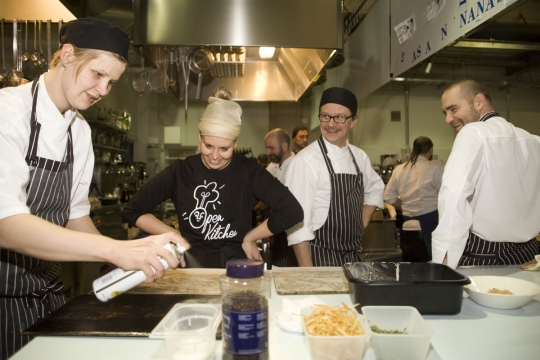
Saila working with the Marrot team in the kitchen. Photo: Matti Tanskanen
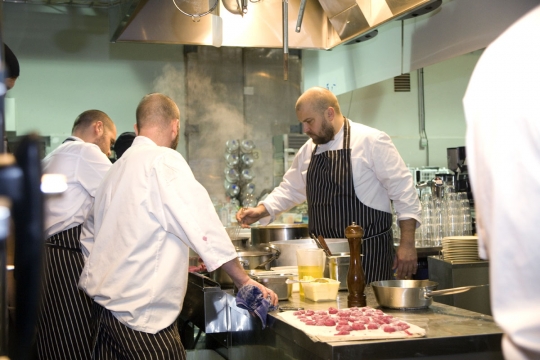
Antto doing this thing. Photo: Matti Tanskanen

A simple, pleasant nordic interior. Photo: Matti Tanskanen
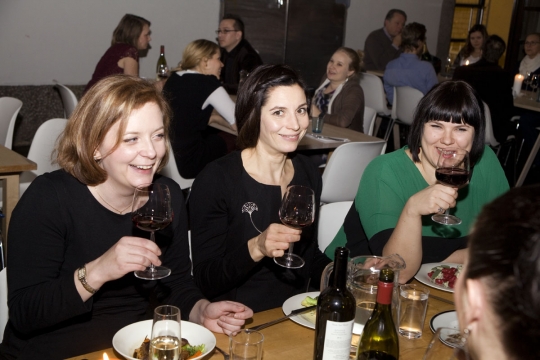
Happy customers! Photo: Matti Tanskanen
Between all of this, Marco, Justin, and I have been finalizing the goals for HDL 2013. I think we have a shared understanding of the goals now, but more on that in the new year.
Ten thousand meters over Trondheim and everything is a luminous black. The only light visible is an icy blue dot, steadily blinking on the wingtip of this Airbus A330. So yes, another flight. I'm on my way back from Helsinki after almost three weeks on the road in Canada, the US, and Brazil.
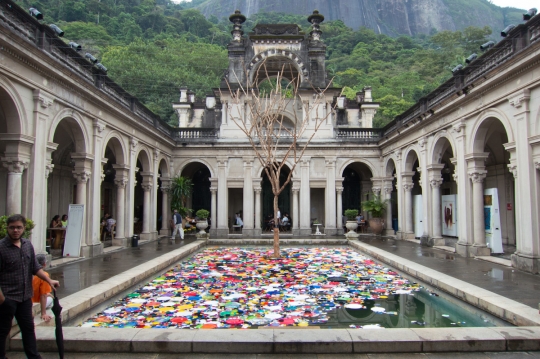
The photos in this post are snapshots from Rio, where I was giving a talk at the Creativity World Biennale...
While I've been giving talks in what seems like just about everywhere, Justin, Marco, Kalle, Maija, and Anna have been more than earning their living by keeping the projects on track.
On the top of our minds right now is Open Kitchen. We've been finalizing the roster of speakers, writing assignments, and briefing speakers. The first item has proven to be a little tricker than we anticipated and so we are finishing things at the last minute. All of the contributors to the programme are people who have a wealth of practical experience and are active entrepreneurs, regulators, restauranteurs, designers, right now. While this is great in terms of the experience they bring to the sessions, it also means that peoples' schedules are harder to contend with. Our neat and clean thematics for each day of the programme have become slightly less crisp in the transition from top-down planning to emergent reality. We made the explicit choice to favor quality of content over ease of scheduling, though, so this is what we get!
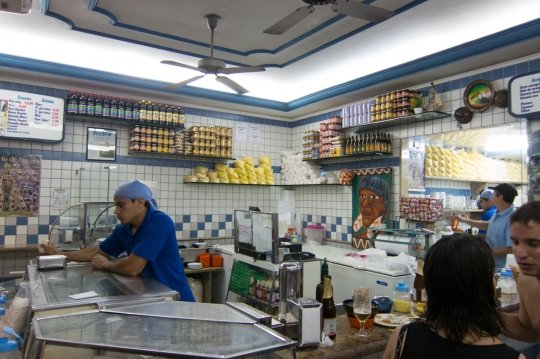
Of course I took the opportunity to check out local street food and other eats. Açai remains my favorite snack in Brazil.
We're also excited to have selected two Aalto University students who will work with the Open Kitchen participants to design their collaborative restaurant. It's going to be a barnstorm—they will have two days to do everything from menus to interiors—but the pair are talented so I think we'll see good things from them.
Marco had a busy day yesterday. He started the morning with an appearance on MTV3'sHuomenta Suomi (Good Morning, Finland) show to discuss the World Design Capital and then spent the day in Finlandia House MC'ing the closing event of the WDC. Lots of familiar faces were in town for that, so I'm especially disappointed to have missed it.
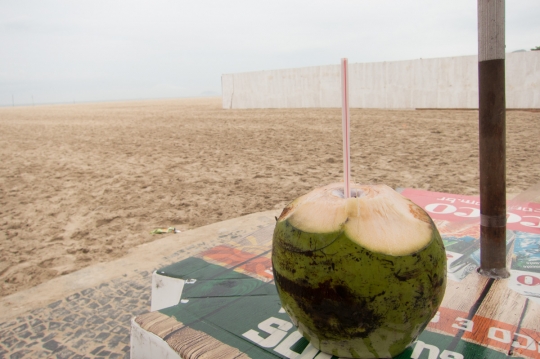
The coconuts were not too bad either.
Maija and Erkki have been in eastern Finland meeting with a town there about the possibility of doing a sort of micro-Brickstarter prototype. I happened to run into Candy Chang, a friend and former neighbor, while I was in Rio de Janeiro, and we were able to share notes. She is part of the team behind Neighborland. Meanwhile, we are pushing ahead with a reflective summary and wrap-up of our research in this area. I'm rather behind on some writing for the site. That's likely to be part of my weekend.
Jaana, our embedded designer in the City of Helsinki Social Services dept, is off to the races with the redesign of the website and access channels for their in-home family care services. We should have something to show there by the end of the year, but no promises just yet. It's about to be pikku juolu (lit. "little christmas") season in Finland and that always seems to stretch timelines.
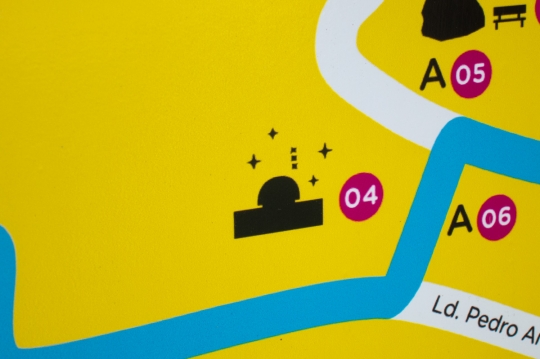
An excellent icon for one of the local observatories.
As a last thought before dutifully stowing my laptop and preparing for landing, I'm grateful to the many people I had the pleasure of meeting across Canada recently thanks to my trip there hosted by Social Innovation Generation. Nate Archer, Cameron Norman, Geraldine Cahill of MaRS, and ISIS at the Sauder School of Business in Vancouver took the time to blog about my various talks there.
And there's the red light and the reliable bing-bong of the landing preparation ritual.
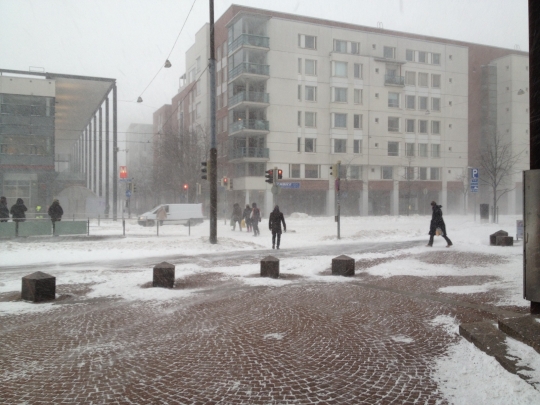
This is the scene from the office, after landing. Quite the contrast.
First, some big news. We're sad (but proud and also happy!) to announce that Dan has moved on from Sitra and has taken up a new post as CEO of Fabrica, the communications research center of the Benetton company. He will be back to make a final post on this blog in the nearish future, but currently he's a bit pre-occupied with his new work in Italy. As you might expect!
Second, some less big news. We published four booklets recently. Read more about them here and here.

Publication dummies all lined up
It's only Wednesday so this weeknote is coming early. I'm in the air somewhere halfway across Canada. Actually, just south of a town called Outlook, which is an ironic thing to spot when glancing up from my inbox to scan the inflight map.
Tim Dramin and his excellent team at Social Innovation Generation (SIG) have been hosting me for visit to Toronto these past two days. MaRS has been by nexus during these days and it's a bit like hanging around an alternate reality version of Sitra. We're different in important ways (they incubate and we don't, for instance) but there's a familiar buzz in the air. Before that I was in Montreal with the McConnell Family foundation, and currently I'm on my way to Vancouver where I'll be hosted by Al Etmanski of SIG West.
These days have been (and will continue to be) packed. Canada seems to be mobilizing quite an effort around labs of various sorts: design labs, change labs, social innovation labs. There's an investment in codifying the various types and I'm curious to see how this evolves. Lisa Torjman's paper from earlier this year, entitled Labs: Designing The Future, is a good starting point, as is the Policy Horizons Canada document which was recently published. HDL's appearance in both have provided useful opportunities for us to see ourselves anew through someone else's analysis.
We got roped into the lab discussion in Canada and have since been enjoying an ongoing dialogue about what a lab is and what it does well. But here's a secret: we didn't choose the name "lab," we inherited it.
To be honest, all of us here on the HDL team have felt a bit uncomfortable with the term since we started ramping things up in 2009. Our initial skepticism came from a sinking feeling that "lab" was a bit of a trendy term. On the other hand, there was already momentum behind the name, and something of a legacy. So, as hard as we tried to make up a better name, we weren't able to. We accepted it for what it was and is: just a name. Plus, it performs well as a search term, which is not to be underestimated.
If I remember correctly, the top alternative was Strategic Design Lab. The reason we nixed that option is because it's too generic. It's harder to search for. It gives you nothing to grab onto. Our work, even when we have a global perspective, is rooted in Helsinki. It's an ongoing discussion and an evolving practice that draws from the legacy of Sitra and that of design in Finland and the broader Nordic region.
And almost by accident—or was it subconsciously?—we've arrived at a place where many of our projects are situated within the city. Today more than when we began things, our work is starting to look like Helsinki Design Lab. Speculating on and prototyping future Helsinkis. That's a topic for another day.
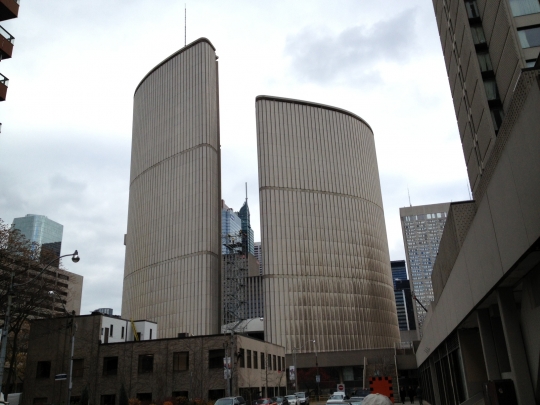
Toronto City hall designed by Finnish architect Viljo Revell
Still, "lab" has been the active word in my trip to Canada and I've been reflecting on how we define ourselves as a lab. If we're to own the fullness of the name Helsinki Design Lab, what does that mean? What is a lab? What is our lab? The notes I wrote on my way to Canada earlier this week:
Lab: platform for coherence and continuity
Lab: conducts experiments to generate evidence that guide further experiments
Lab: should have a portfolio of activity (not just one thing)
Lab: not a process but a practice
Lab: a place (but nothing fancy)
Lab: a core team
Lab: has a set of (consistent) tools
Lab: hosts an evolving conversation
The strength of our lab resides in the fact that we're able to work in an agile or nimble manner. Continuity on a basic level (funding, infrastructure, team, tools) enables us to pursue an evolving portfolio of projects using whatever combination of processes and tools are most appropriate for the specific projects at hand, in the specific moment.
This agnosticism towards tools and processes enables us to be flexible and opportunistic when we need to be—or put another way, when being flexible is the cheaper, faster, or easier pathway to our desired impacts. When we need to pivot, we can pivot. But pivoting is not easy, so the continuity of our shared practice is important. We've literally had to practice this work together to become adept at it. It's a new approach to producing social change, so I think it would be silly to assume that we could get that right without practicing in quite a literal way. One can only read so much music theory before sitting down at the keyboard, as it were.
In practical terms this means that we maintain a basic ability to reallocate our staffing, our budgeting, and our approach to a problem when necessary. This is not easy, but it's critically important. By definition, when doing something truly innovative it's not possible to predict all aspects of the work in advance. With the hindsight of 100 years from now, the belief that such planning and prediction is cheap enough to bake into everything we do will seem like a glitch. Measurement and feedback loops, yes, but we will have to find a way to integrate some degree of fuzziness.
Factories stamp out the same ole widgets, but labs are about developing an understanding for how to do new things. They are places where we expect to see configurations of equipment half deconstructed and reassembled into motley but functional piles. It's not just our desks which are messy at HDL/Sitra Strategic Design Unit, our work is also messy and unpredictable at times. It speeds up and slows down; it goes over budget and sometimes comes in under budget; but every now and then we hit upon something truly effective and that helps us learn about the world.
For a lab, and especially a lab situated within an organization like Sitra that has a financial acumen, the portfolio is the most natural scale of evaluation. Is the sum total of everything the lab is involved in net positive? It's easier for our colleagues in the endowment capital group to check their mixed portfolio of different asset classes and get a sense of whether the numbers are up or down—regardless of asset class, they're all reporting in euros. For our work we're sometimes struggling to make sense of numbers, intuition, and narratives. These make difficult bedfellows as metrics to assess a single portfolio, but it's something that we've developed a skill at through a four year conversation within the team. Good. The next question is how to codify that so that the next group can figure out how to do it in half the time. Eventually we'll all get there.
That's the thing, isn't it? We have 150 years of practice (or more) in predicting and working with financial indicators. It may be extremely important to develop ways to do the same with social indicators, but that doesn't mean we should expect that it will happen faster. We can and should desire that we, as a society, skill up in this area much more rapidly than we did with financial capital, but the likelihood is that we will be struggling with these questions for decades to come.
So I return to the lab as a platform of continuity that hosts an ongoing and evolving discussion around a limited set of issues. One that nurtures knowledge and produces evidence. One that serves the outside world and itself benefits by having feedback loops that enhance the next efforts. The goal of our science labs is not just to produce breakthroughs in their own particular corner of study, but also to become better at science itself.
The practice we're nurturing is strategic design. We're developing a way of designing tangible projects that help us identify and act on systemic change opportunities. We're developing ways to use projects to help us see and then change our cultures of decision-making. We're developing projects that have incremental tangible outcomes so that if they become compromised, canceled, or failed before reaching their final goals that we will still be left with some form of net positive results.
Tomorrow comes to us courtesy of the relentless incrementalism of today, and sometimes (but rarely) we find a beautiful shortcut. If there's one thing a lab does, it's to deliberately search for these shortcuts and then run through them as fast as it can.
Gray. Dark. From the Sitra tower one sees a vista of offices, homes, and shops glowing warmly beneath a thick cloud cover. The idle booms of a coal ship docked not too far away shine orange under sodium-vapour lights. At ground level metal surfaces reflects the red of brake lights, meaning people are on the way home. Marking the horizon, a strip of faint and fuzzy peach just visible beneath layers of dirty, gauzy, clouds.
More travel these past two weeks (not unlike one year ago). In week 188 Marco was at Dutch Design Week and then at a session at the Danish Parliament (which we all enjoyed hearing about because we are hopeless Borgen fans). He's just back from Moscow, where he was part of a session on the development of Skolkovo. Last week I was in Portugal to give a talk at Cidadania 2.0 (Citizenship 2.0) and then took a day off in Barcelona before coming back north. While there it was nice to catch up with Martin Lorenz and Lupi Asensio of TwoPoints, who did the visual identity for HDL as well as the design of In Studio.
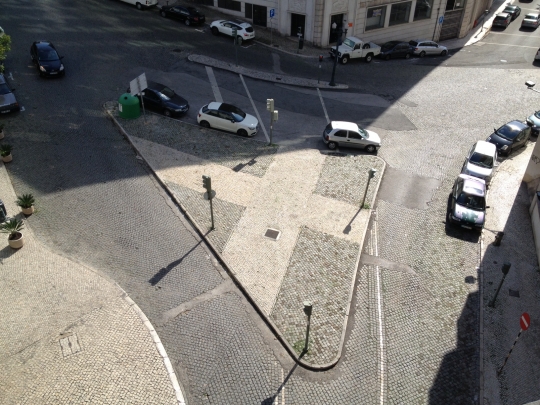
An almost-Finnish-flag literally on the streets of Lisbon
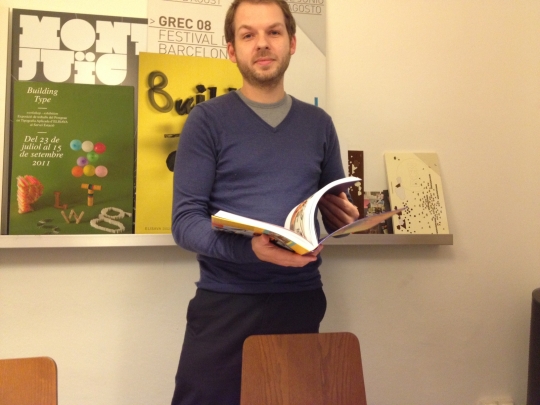
Martin explaining that "there's no ugly anymore, just boring."
In Lisbon Frederico Duarte gave me a tour of the city (and its food). A couple months ago Frederico wrote about Helsinki Street Eats in a profile of the city that he did for Fugas Publico, so it was nice to be able to meet in person. His own recent publication on the cakes of Portugal is an enticing read. I'm quite glad that I got a copy of it at the end of my trip or I might have come back a few kilos heavier.
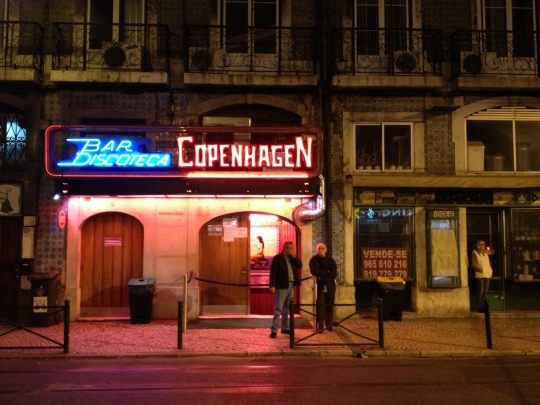
Lisbon has a nordic nightlife corner with clubs named Oslo, Copenhagen, and Viking. Who's going to start Helsinki?
On Monday we announced the participants for Open Kitchen. Out of 53 applicants we were able to make room for 13. The response was overwhelming and most of the people who applied did so by video (as we requested). The enthusiasm and eloquence in the videos is something that we want to share with you too, so Kalle is hard at work editing them into a single clip. Once we do that and get permission from everyone we'll post it here and on the Open Kitchen Facebook page.
The diversity of the applicants is what excited me most. From 19 to 40+, Finland to Brazil, burgers to ancient preservation techniques, we had a bit of everything it seems. We tried our best to capture that in the final group:
- Archibong wants to fuse African and western food
- Saila wants to give shape to a new kind of ice cream
- Mark dreams of smoked meats (and some bacon sandwiches, we hope)
- Anni believes in stylish an uncomplicated lunches
- Fatim's social kitchen will be an anchor point for newcomers to Finland
- Alba will bring the warmth of Mediterranean dining to Helsinki
- David is investigating ancient preservation techniques
- Elaine is going to show us how Brazilians do effortless nose-to-tail dining
- Jérôme tells us that bread is about friendship
- Jonatan & Nicklas are pure energy and enthusiasm
- Nguyen thinks Vietnamese food in Finland can be better
- Veronica believes in food, flowers, and friendship
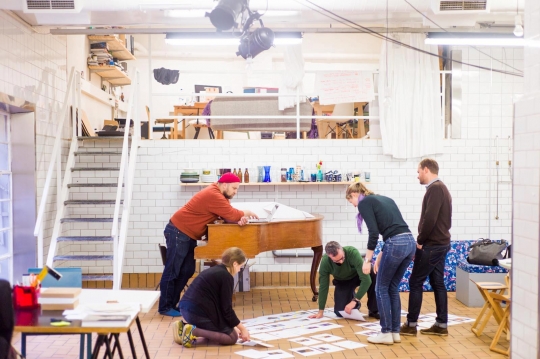
Jurying the Open Kitchen applications was quite a task.
Next steps with Open Kitchen are to launch a similar call for two design students to help the team design and build their prototype restaurant. If this sounds interesting to you (and you're based in Helsinki) please follow the Facebook page for an update next week.
Brickstarter needs more attention than we're giving it at the moment. Maija, Dan, and I have a lot of writing to finish up. We sketched that out on the whiteboard last week, but unfortunately there's is not yet a device to turn marker scribbles into coherent, articulate prose. We are currently exploring the possibility of doing a MVP (minimum viable product) version of Brickstarter with a municipality that's east of Helsinki. More details when they're stable.
A trickle of HDL 2012 feedback has been coming in, including corrections and amendments to the cases we wrote. Next week we will be making some decisions about whether or not we put the cases together into a publication, and if so how. That's part of a larger discussion about what the future holds for HDL.
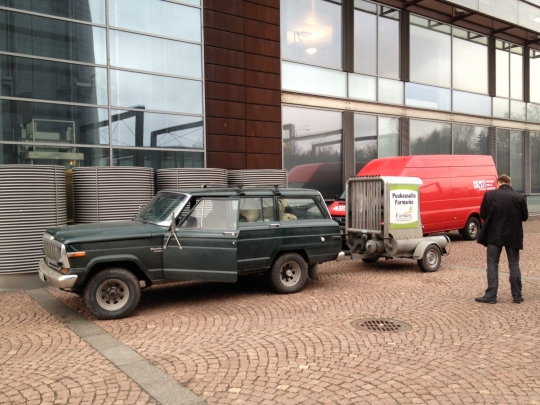
A wood-fired car visited Sitra. It's gasifies wood chips!
Which leaves us with a long overdue project, a booklet that we comissioned the OpenEndedGroup to write. I spent the week checking all the final boxes so that this can go to press and get pushed live on the website for downloads. That'll happen early next week, so all I can do for now is tease you with these images. It's a plain spoken booklet about how to collaborate on creative projects. It's the kind of thing we might encourage people to read before joining us for a studio, for instance.
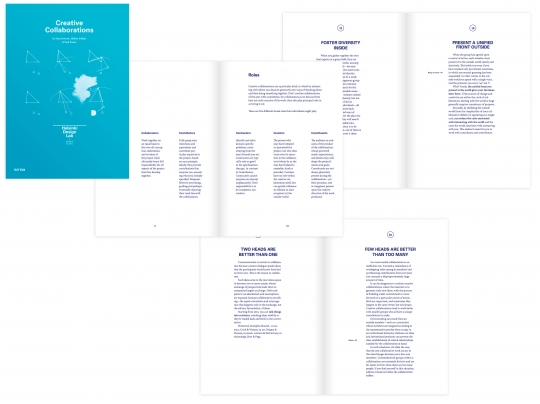
Creative Collaborations by Marc Downie, Shelley Eshkar & Paul Kaiser. Publication forthcoming!
Before I end this weeknote and begin my weekend, two announcements for November. Social Innovation Generation (SIG) is hosting me for a tour of, well, most of Canada. In Toronto I'll be giving a public talk that you can sign up for here at 18:00 on the 12th. We've had an ongoing discussion with SIG and a few other groups in Canada, as well as receiving more than a couple visitors here at HQ, so I'm looking forward to seeing things on the other end of this cross-atlantic friendship.
After Canada I will be heading to Rio de Janeiro to give a talk at the Creativity World Biennale. And then I will sleep for a week straight.
It would be excellent to meet readers of this blog at these events. If you're attending please say hello.
It's only tuesday and already the supply of stroopwafels in the office is dangerously low. As is customary on our team, on a trip to the Netherlands one is obligated to return with wafels. I was in Eindhoven at the end of last week and I did my duty, but apparently I miscalculated the quantities. More about the trip in a moment, but first we need to get to something rather incredible.

Open Kitchen also has a new logo courtesy of Sanna Mander!
Applications for Open Kitchen closed last monday and we got roughly 50 applications and the lot of them are impressive! We asked people to make short videos that describe themselves, their experience, and how their food concept will make make Helsinki a better place. The applications included people who excited about cakes, tapas, pho, flat whites & avocado toast, flower ice cream sculptures, traditional food preservation techniques, burgers, sourdough breads, and someone offereing a conceptual menu that begins with a starter of "loneliness" and continues with an entrée of "empathy". So in other words, this is all fantastic.
What we heard from the application videos is that Open Kitchen is exactly the sort of thing people have been waiting for. Now begins the difficult task of winnowing it down to a batch of ~12 people who we have room for in the programme. Tomorrow is the day for that and we'll be balancing multiple criteria:
- Sustainability: is there a concern for local and sustainable aspects of preparation, logistics, consumption, recycling?
- Diversity: is there a new kind of cuisine, a new experience, or a new perspective?
- Everyday: is the applicant interested in basic food experiences (not fine dining) that improve everyday life?
- Social: does the applicant see food as a social object that creates a bridge between diverse publics?
- Drive: does the individual show drive, determination, spark, verve, commitment?
The final selection will be posted next week. We are also hoping to post some examples of the applications, but first we need to get permission from the applicants.
To get the word about Open Kitchen we did an experiment with Facebook ads. We spent a total of €350.62 running two parallel ad campaigns for about 3 weeks. These were targetted to all people living in Finland age 17 or older (about 1,969,280 total Facebook users). To put this into perspective, it would cost €430 to have a banner ad on the popular Nyt.fi website or about €3,000 to have a small ad in the print version.
The response was rather rapid and we saw significant growth of the likes on the Open Kitchen Facebook page, an increased number of questions, and people sharing our posts. What we don't know yet is how many of the applicants found out about OK on Facebook versus other channels. Kalle will be following up with everyone to inquire about that so we have a better picture of how useful this method of advertising was. Here's a view of the stats for the lifetime of the campaign:
Dan had a good meeting with Jaana, who is our Design Exchange person working at the Helsinki Department of Social Services. He, Marco, and myself will swarm with Jaana on a quick project that she's starting now. The gist of it is that there will be an experiment in making preventative help more accessible, ranging from basic parenting advice up to complicated social difficulties. We think this means a combination of new online and offline possibilities to get access to help before there's a problem, but we're not exactly sure yet what shape this will take. It's Jaana's project, but we're here to help.
Down in Istanbul our installation of Brickstarter is now open to the public as part of the Istanbul Design Biennial. If you're not able to see it in the flesh, you can check out the boards we presented here and a bit of backstory here. This opportunity came up at the last minute and it was quite a lift to get the exhibition squared away while also finishing up everything for HDL 2012, but in the end I'm quite happy with how things came out. As an added bonus, the boards for the exhibition are useful as slides to be used in Keynote (thanks to the magical Magic Move transition).
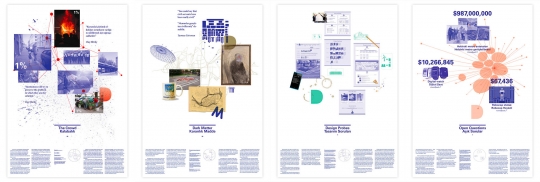
The Crowd, Dark Matter, Design Probes, Open Questions
After HDL Global 2012 concluded Marco and I both got on planes for Italy. He took a well-earned week off with his family. I was headed to European Center Living Technology to share our perspective on strategic design as part of a meeting about Envisioning a Socially Sustainable Future.
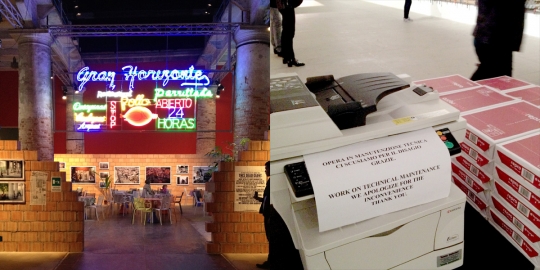
While in Venice I had a morning to visit the Architecture Biennale, which was useful to see in comparison to our own work in Istanbul. We've installed a "grumpy printer" and it appears that FAT are of a similar mind with their contribution in the Biennale (one of the highlights).
From there it was on to Ljubljana to be part of their Month of Design with a delegation of other colleagues from Finland.
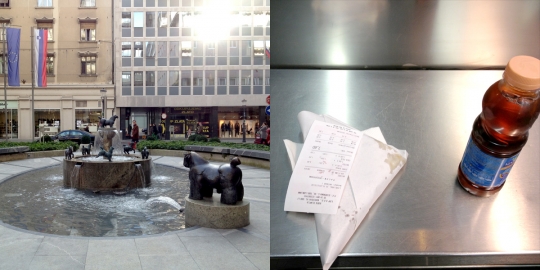
Out and about in Ljubljana. A local friend took me on a street food tour, of which the Burek was the highlight.
And the week ended in Eindhoven where I gave a talk at the World Design Forum and then loaded my suitcase with stroopwafels. Doug Belshaw's thoughts on that event are worth a quick read. Hearing about Doug's work on the Mozilla Open Badges project was one of the highlights for me, as was getting a chance to catch up with John Thackara who moderated the day with aplomb. The organizers have also posted a summary, which is impressively quick considering our HDL 2012 event happened more than a week ago and we're still ruminating.
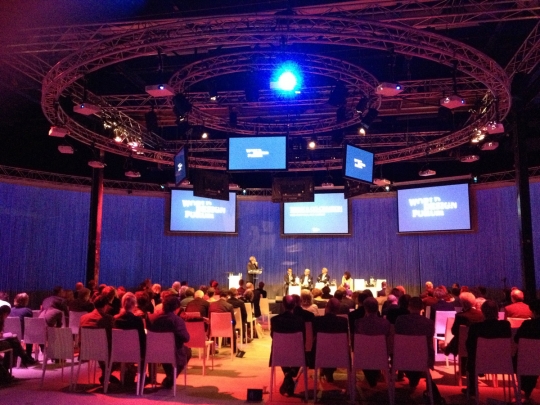
The World Design Forum featured an impressive number of projectors. So many that it kept distracting me from the discussion.
Marco is in Eindhoven now and Copenhagen later this week for Creative Summit (PDF link), Justin's in Boston, Dan's holding down the fort, and I'll be in Portugal for Cidadania 2.0 (Citizenship 2.0). Between travels we're continuing to process HDL 2012 so that we can post more reflections here, picking up where Dan left off last week.
Goodbye, Week 187, you were good to us, but now we must move on.
Last week we hosted Helsinki Design Lab Global 2012. The event was almost a year in the making, and you would've seen it referred to obliquely a couple of times here. We'll post a fuller update shortly, including our ideas about how we will distil and make legible (our favourite word) the conversations and connections.
We use Helsinki Design Lab—this site, social media, publications, events—as our communications platform around strategic design, capturing and conveying the essence of our projects, of other interesting projects out there, or building a network of like-minded folk doing similar work elsewhere, all in an attempt to breathe life into this practice, or culture.
Sometimes this emerges as fully-formed recipe books, sometimes as meetings which are somewhere between therapy and benchmarking. It's our tentative contention that there is a shared culture developing—around getting things done, in a "shared value" public context—and so we work hard to spot useful, transferable examples of such a culture, and bring together the people responsible so they can swap notes and find the time to reflect.
In this mode, our role is hosting, and then we have the privilege of listening, occasionally nudging, before going on to try to distil and document the salient points. More on that later.
But some quick hits for now:
Over the summer, we pulled together representatives of six groups doing interesting work, organised them into three productive pairings in New York, London and Copenhagen. Then we talked, for a day and a bit, about stewardship in and around their projects. It was incredibly interesting, and formed the foundation for last week's conversation.
The six projects were:
- Brownsville Partnership, NYC, by Community Solutions, which we paired with the approach to rebuilding Constitución, Chile, after the 2010 earthquake, by Elemental/Tironi Asociados;
- The Branchekode project by Mindlab within the Danish government was paired with the GOV.UK project by Government Digital Service at the UK government;
- And Nesta's Creative Councils project in the UK was paired with a project by IDEO for the US federal government.
Bryan, Justin, Marco and I then distilled the results of those "mini-summits" into six summary case studies, pulled out some key maneouvres or strategies to form a kind of emerging lexicon (a little like the vocabulary I sketched out a while back) and topped it with a short intro that Bryan and I wrote about this "craft", for want of a better word.
Last week, representatives from those six groups joined us in Helsinki, along with a few other invited guests, to review the cases as we'd described them, and spend a day in shared conversation digging deeper on the topics that emerged.
The wider group included representatives from Bengler (Norway), Cisco/LSE (UK), Community Solutions (USA), Elemental (Chile), Evergreen (Canada), City of Helsinki's social services department, IDEO (USA), Innovation Unit (UK), Mindlab (Denmark), Ministry of Trade and The Economy, Finnish national government, Nesta (UK), Sitra (Finland), Social Science Research Centre Berlin, and Tironi Asociados (Chile). (Government Digital Service couldn't make it as they were launching the gov.uk site, which is fair enough.)
Again, part of this is just bringing a network together. This kind of work is somewhat solitary—there simply aren't that many doing it yet, and although most people who know of it, or hear about it, can quickly see the potential within it, it's still a marginal affair, all told. Important projects; just not enough people doing them. So again with the therapy and empathy-building. But beyond that, we were after what is unique, or just plain useful and productive, about this culture? (And what is not?)
And in terms of that question, HDL Global 2012 had a particular slant. Where HDL Global 2010 had been a larger event, drawing out the network for perhaps the first time, this was a more focused affair. And where 2010 had followed the studios, and focused on the rapid prototyping of vision that was documented in the book "In Studio", HDL Global 2012 focused more on the next step—stewardship. As in, having located a vision, and strategy, just how do you make things happen?
So, this Autumn, an event in Helsinki.
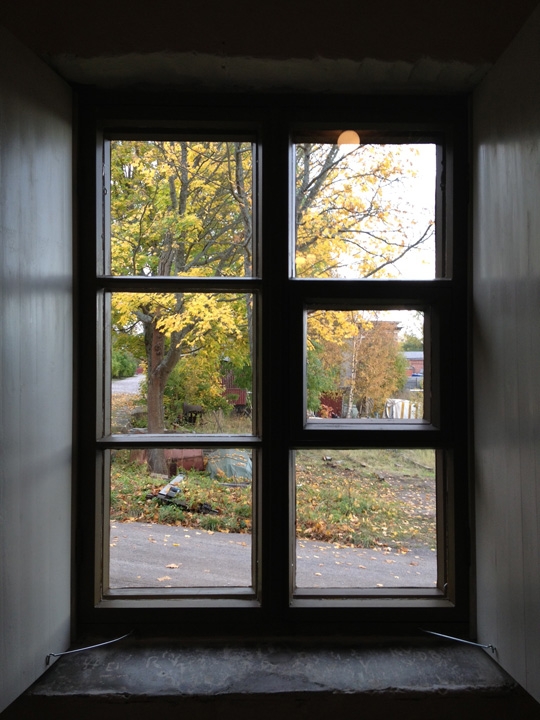
Here is Autumn.
Some details. We sent a small book containing the cases, and background, to the teams as they arrived, the afternoon before the event in most cases. We met for dinner that night. We like to start with a dinner, as it enables people to introduce themselves in a more social setting, and gently begin approaching the subject at-hand at a leisurely pace. You can then hit the ground running the following day. This is partly about getting the messy introductions out of the way, more carefully building relationships without the need for absurd "icebreaker" moments at the start of the event.
And partly because we just like to have dinner.
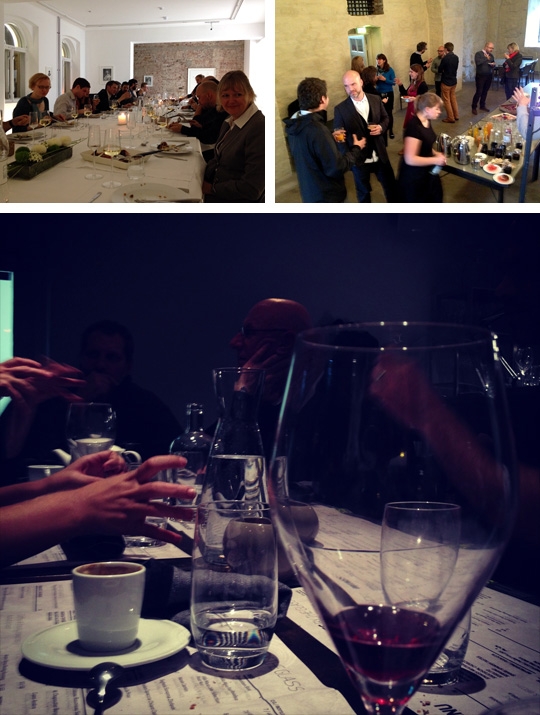
Food as a platform for discussion: before, during and after.
The following morning, we meet at Helsinki's famous Kauppatori (the market square at South Harbour) and take a boat ride to Suomenlinna, the old island sea-fortress that used to guard the city.
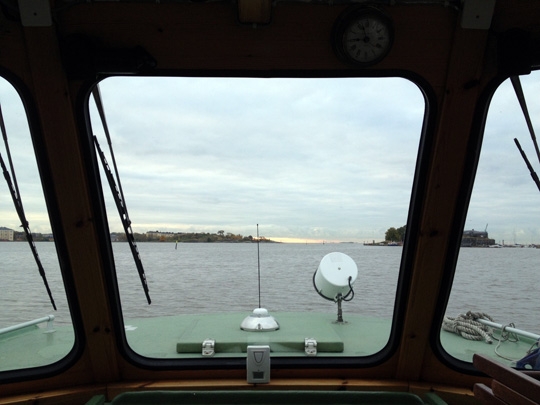
The 20-minute ride to Suomenlinna
Suomenlinna, needless to say, one of Helsinki's great assets and luckily the Autumn weather was just brisk enough to wake everyone up without chilling them to the bone. A delicate balance, round these parts. Our venue was an old warehouse—possibly an ammunition store, looking at how the deep windows were angled—which was an evocative space, and Bryan, Justin, Kalle and Maija did a great job in terms of ensuring the space and the catering were top-notch.
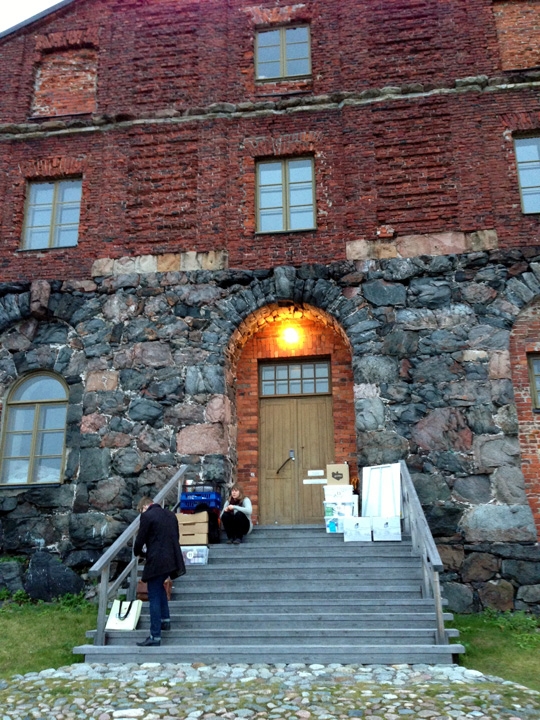
Setting up the venue before the guests arrive.
Our format was simple. Marco started the conversation with a scene-setting talk; Bryan, Justin and I then introduced the cases, and asked for clarifying comments from the participants, as well as reflections on where their projects have gone subsequently.
Then, with breaks, lunch and a walk, we had a group conversation.

Before kick-off.
It occurs to us that we're very comfortable with the open-ended conversation. Those that know us well might say "overly comfortable". That may be the case, but I've had my fill of the alternative: overly-planned, clumsily-facilitated and tricksy workshop formats that leave little room for sudden inspiration or careful reflection, and head inexorably towards whiteboards covered in scribbles captured only in diligently Dropbox-bound photos, or their equivalent, flipchart sheets full of bullet-pointed lists that no-one owns, destined to remain rolled up under the facilitator's desk forever. Whereas the open conversation can be held over the course of a few hours, expanding to a group session in the room or contracting into smaller groups over lunch or coffee, and—given the nascent properties of the subject matter—provide ample room for the genuinely exploratory exchanges required.
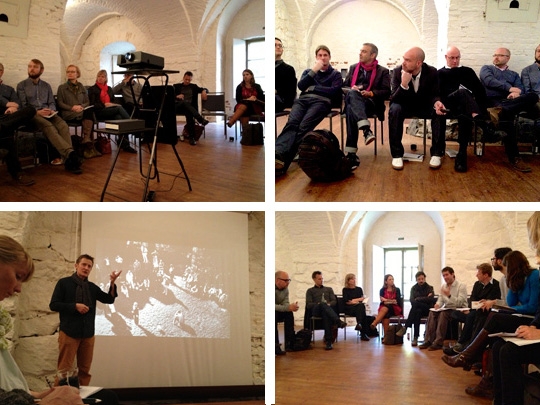
HDL2012, in session.
You might spot Marco operating a slide projector in the photos. This was one of our many subtle (and not so subtle) habit-breaking gestures. It's a basic thought, and perhaps hardly necessary with this particular group, but with the public sector, we often need to derive different outcomes from the same organisations. Given this, one thing we need to do is destabilise the everyday habits of organisational cultures, to shake peoples' defaults, remove the subsconscious inhibitors of change without destroying culture completely. And if a core theme of all of our work is around developing an "institutional sense of empathy", then we need to heighten awareness of the qualities of things, not simply the easily measurable quantitative aspects that bureaucracy all too readily gravitates towards. In practice, this means assessing the symbolic messages contained in active choices about formats, food, location, rhythms, spaces, and so on. It's why we choose a disused warehouse on an island rather than a conference centre or hotel; it's why we had dinner the night before at Helsinki Contemporary Gallery rather than a restaurant; it's why we pay particular attention to our printed matter; and it's why Marco was operating a slide projector.

Marco selects his slides before the event.
For most in the HDL2012 group, this was hardly necessary, as they spend most of their days delivering real change in richly messy public contexts, after all. Either way, the conversation flowed readily. Reflecting on it a few days later, it is somewhat extraordinary that we can find very similar approaches to stewardship in projects as diverse as the emergency reconstruction of a Chilean city demolished by earthquake and the redesign of a government web service. But we did, and in the space between all the projects we could see strong connective tissue being constructed across and within the group.
As the light began to draw in, a boat turned up at our dock at Suomenlinna, and it was back to the mainland for dinner, and then flights home.

The last few heading for the boat home.
So that was HDL2012. We have "proper" photos to follow, but more importantly, a sense of where our distillation and documentation might go next. For now, our notebooks, and heads, are full, and while we reflect on the key messages while they're relatively fresh, we would like to extend our immense thanks to all the participants in both the summer sessions and last week's event.
(In other news, applications for our Open Kitchen project closed this week and, having had a quick glance over Kalle's shoulder as they've come in, we're pleased with a good set of diverse applicants. More to follow there too. Ditto Brickstarter and Design Exchange.)
I'm procrastinating. Sitting next to me is a pile of paper covered in red scribbles. Those scribbles need to get into my computer and fight with some pixels. What comes out the other end will be a series of six case studies crunched down into a digestible format. Standing between us and the weekend are 9000 words. It's not clear yet who's going to win this battle.
The team are scattered, off doing various things, and Maija and I are in the HQ tending to the never-ending HDL logistics for next week. Wooden boat? Reserved. Hotels? Confirmed. Having just done a tasting, I can tell you that the reindeer we'll be having for dinner next week is delicious, in case you were wondering.
Marco spent a good chunk of the week interviewing candidates for two more Design Exchange Programme placements. Once they're selected and hired in we'll have a total of four embedded designers.
This is what I keep thinking about:
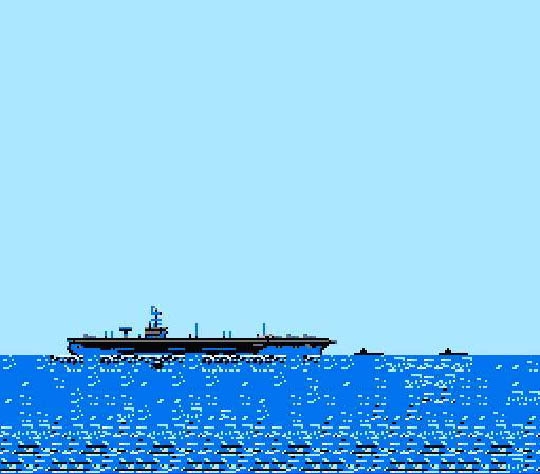
The hardest part of the video game Top Gun was landing your plane on the aircraft carrier. Get the carrier in your sights, modulate the throttle, adjust yaw, avoid roll, and land smoothly on the deck. "Stay on target," as they say.
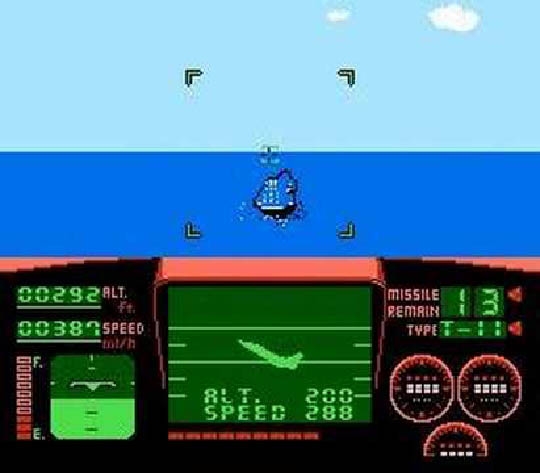
Alongside the preparations for HDL 2012 next week, we've just presentation boards to Istanbul for the Design Biennial there which will feature Brickstarter. Now we know now to say "Dark Matter" in Turkish.
The last piece of that project is an application which will control a laser printer that will be zipping off letters to the 'Public Works Department' on regular intervals. Testing is coming along OK but we still have some bugs to squash.
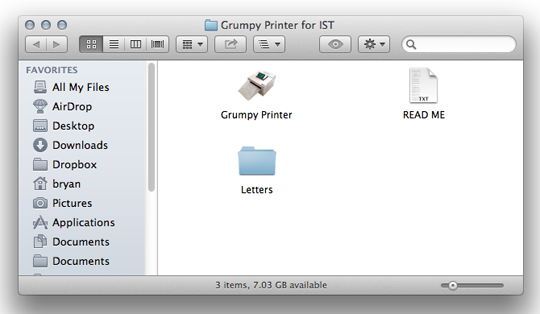
Next week Helsinki will host a gathering of the Délice Network of "good food cities," so we took the opportunity to revamp Helsinki Street Eats to include information about Open Kitchen. We still need to find more time to do a proper update, but for now this is better than nothing. This edition features a new cover as well. Why not. You have 10 more days to apply!
